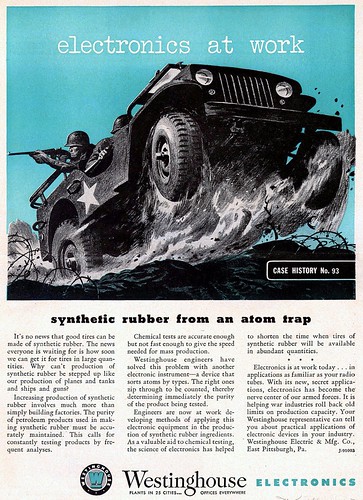Natural rubber was the preferred material for tire manufacturer prior to World War II. It was cheaper and readily available. While some of the naturally occurring rubber came from Africa, Central and South America - the bulk of it came from Southeast Asia (especially the Netherlands East Indies). This of course caused a problem as Japan controlled much of Southeast Asia in their expansion efforts.
Jeep vehicles and other military vehicles would be stopped in their tracks without a substitute for natural rubber in their tires. Planes, trucks and Jeep 4x4s all depended upon rubber to keep the War machine moving.
Synthetic rubber wasn't new technology, it was typically a mixture of oil, natural gas, coal, acetylene, and other items. But it was expensive.
B.F. Goodrich Company, with the help of scientist Waldo Semon, developed an cost-effective synthetic rubber call Ameripol in 1940.
The first synthetic tire was unveiled to the U.S. public by B.F. Goodrich on June 4, 1940, eighteen months before Pearl Harbor. More than half of the tire was synthetic, but was 1/3 more expensive.
The U.S. Government launched a major campaign (some of which was top secret) to help improve synthetic rubber production lower costs. The nations technical powerhouses came together during the war to produce a general purpose synthetic rubber known as GR-S (Government Rubber-Styrene), on a massive scale.
With the fear of losing the war at their hands, America's scientists, university research laboratories, and the petrochemical industry industry collaborated to produce almost a million tons of high-quality synthetic rubber in 18 months. Many called it an industrial and scientific miracle. Annual production increased from an annual output of 231 tons of general purpose rubber in 1941 to over 70,000 tons a month in 1945!
Tennessee Eastman began manufacturing hydroquinone (a photographic developer) for the war effort when it was found it helped keep synthetic rubber from becoming gummy.
Goodyear Tire and Rubber Company and Firestone Tire and Rubber Company were instrumental in furthering the development of synthetic rubber products during World War II. According to the book World War II 1935-1945, the War Production Board ordered the construction of 50 synthetic rubber factories.
According to the book, The Magic City - Unemployment in a working-class community, "The government spent millions of dollars to build factories to produce synthetic rubber, which was then sold cheaply to companies making essential war material. After the war ended, Harvey Firestone, who was eager to preserve "free enterprise," spoke out strongly and successfully against government operation of these plants (Lief 1951:354).
